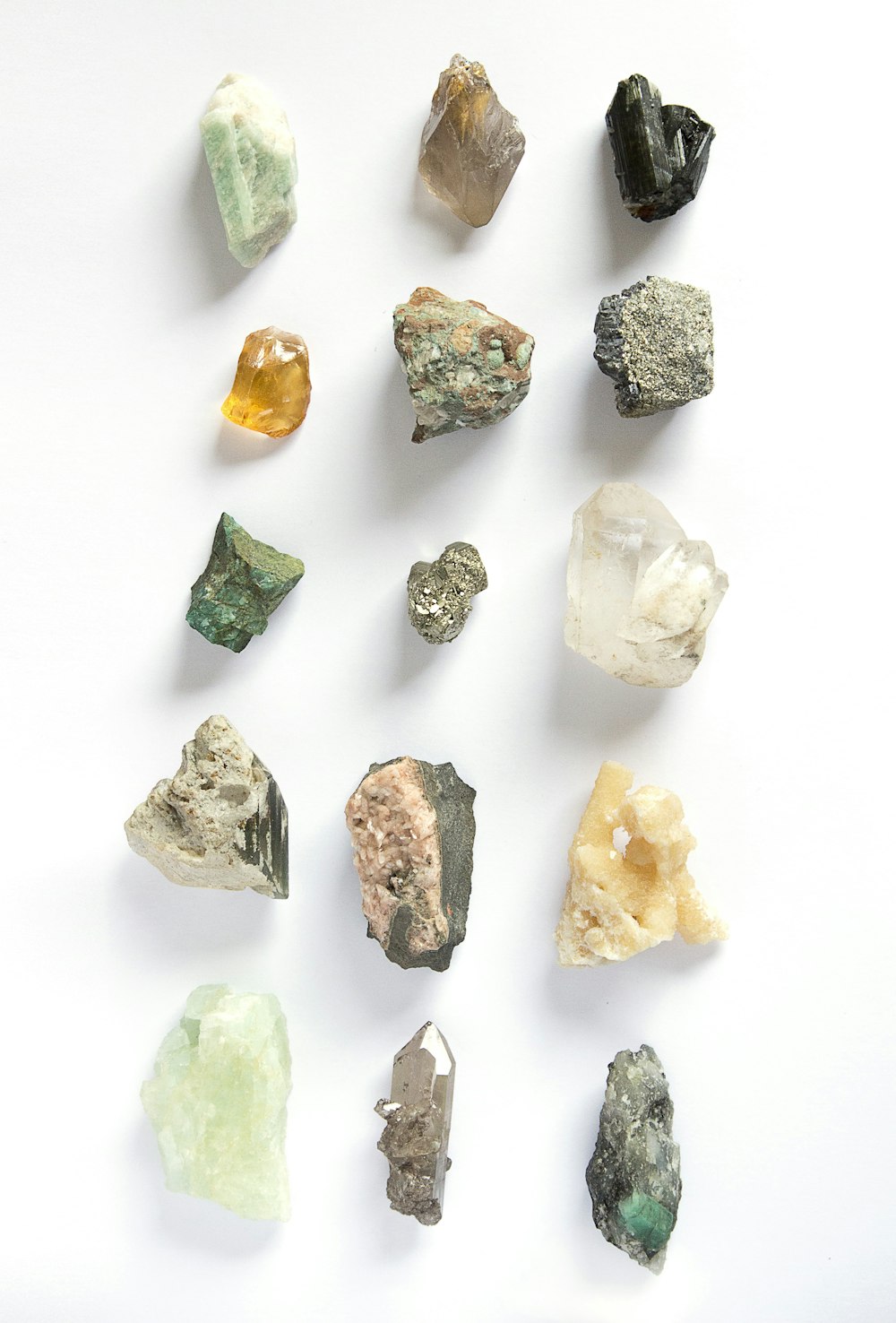20 Interesting Facts About Rocks
*Originally published by Barbara on March 15th 2023 and Updated by Beatrice J on March 2024
You may have noticed rocks in your backyard or at the playground.
Rocks are composed of various minerals, which are herbal, non-living substances found in the Earth’s crust.
Some minerals are very difficult, like diamonds, whilst others are very soft, like talc.
When these minerals combine, they form rocks.
Rocks can also be valuable sources, such as gold or diamonds, and can be used to make building stones or gravel.
Petrology is the study of rocks, and it is essential for understanding the Earth’s history, predicting geological activity, and even locating resources to help us in our daily lives.
1. Rocks are made up of minerals

An assorted colour stone lot. Photo by Franco Antonio Giovanella. Unsplash
Rocks are composed primarily of grains of minerals, which are crystalline solids formed from atoms chemically bonded into an orderly structure. Mineraloids are rigid, mineral-like substances that lack crystalline structure found in some rocks, such as volcanic glass. The composition and abundance of minerals in a rock are determined by its formation.
2. The Earth’s crust is made from rocks
Igneous rocks make up approximately 65% of the Earth’s crust by volume. Sixty-six percent are basalt and gabbro, sixteen percent are granite, and seventeen percent are granodiorite and diorite. The oceanic crust is composed of 99% basalt, an igneous rock of mafic composition. The continental crust is dominated by granite and similar rocks known as granitoids.
3. Rocks are in three types
There are three basic types of rocks, which include:
- Igneous
- Sedimentary
- Metamorphic
These three types of rocks are interconnected, and various geological techniques can convert one type of rock into the other.
4. Igneous rocks are formed from solidified magma
Igneous rocks are formed when magma or lava solidifies and cools. The following are examples:
- Granite
- Pumice
- Basalt
5. Sedimentary rocks formed as a result of sediment accumulation and cementation

Sedimentary rock with very fine grains. Photo by ANBARASU THIRAVIYAM. Wikimedia
Sedimentary rocks form as a result of sediment accumulation and consolidation. Sediments can be formed by the erosion of existing rocks or by the accumulation of natural count. These sediments can be buried and compacted over time, resulting in bureaucracy sedimentary rocks. The following are examples:
- Sandstone
- Limestone
- Shale
6. Heat, pressure, or chemical alteration transform metamorphic rocks
Metamorphic rocks are formed when existing rocks are subjected to such high pressures and temperatures that they are transformed without significant melting. The following are examples:
- Marble
- Slate
- Gneiss
7. The oldest rocks on the planet are 4.28 billion years old
These rocks were discovered in the Acasta Gneiss complex in Canada’s Northwest Territories.
The age of these rocks became decided in the usage of radiometric relationship strategies, which measure the decay of isotopes within the rock to decide how lengthy in the past they formed.
The oldest rocks on Earth, however, are not always the oldest rocks in the solar gadget.
Some meteorites have been dated to be older than the Earth itself, with ages ranging up to four.6 billion years.
The oldest rocks on Earth, however, are not always the oldest rocks in the solar gadget.
Some meteorites have been dated to be older than the Earth itself, with ages ranging up to four.6 billion years.
8. Some rocks are valuable resources

A couple of diamonds sitting on top of a table. Photo by Bas van den Eijkhof. Unsplash
Some rocks, especially those that include precious minerals or metals, can be essential natural sources. They include:
- Diamond
- Silver
- Gold
Copper, iron, and coal are examples of minerals found in rocks that are valuable assets.
9. Some rocks can be dissolved by acidic water
Some rocks, such as limestone and dolomite, dissolve in acidic water and form underground caves, sinkholes, and numerous karst landscapes.
Over time, acidic water can dissolve the calcium carbonate that makes up a lot of the limestone rock, developing voids and caverns below the floor.
These underground spaces can be quite full-size and might create precise habitats for a lot of organisms.
Sinkholes form when the roof of an underground hollow space collapses, causing a depression to form on the surface.
Karst landscapes are discovered in many parts of the sector, inclusive of elements of the USA, Europe, and China.
They are crucial for scientific study and for their cultural and recreational cost. However, they also can pose hazards to human populations, specifically in regions in which sinkholes can motive belongings harm or lack of existence.
10. Petrology is the study of rocks
Petrology (from the Ancient Greek o (pétros) ‘rock’ and – (-loga)’study of’) is the study of rocks and the conditions under which they form.
It has three subdivisions: igneous, metamorphic, and sedimentary petrology.
Igneous and metamorphic petrology are commonly taught together because they both contain heavy use of chemistry, chemical methods, and phase diagrams.
Sedimentary petrology, on the other hand, is frequently taught alongside stratigraphy because it is concerned with the processes that form sedimentary rock.
11. The world’s largest rock is found in Western Australia
Mount Augustus, also known as Burringurrah, is a well-known rock formation in Western Australia and is frequently referred to as the world’s largest rock.
Despite its remarkable size, Mount Augustus isn’t as well-known as Uluru and is positioned in a greater remote a part of Australia.
12. There is a rock formation in New Mexico
Tent Rocks National Monument is located in northwestern New Mexico, USA, and features a completely unique geological formation known as “tent rocks” or hoodoos.
The softer, fragmented rock eroded greater speedy, leaving behind the more difficult, extra resistant rock that bureaucracy the hoodoos.
The name “Tent Rocks” comes from the fact that the rocks resemble tents or teepees.
The vicinity is a popular holiday spot for hiking and exploring the precise geological formations.
13. Some rocks can float in water

Pumice stone. Photo by Ambuj Saxena. Wikimedia
Pumice is a sort of volcanic rock, this is fashioned whilst lava with a high petrol content material is ejected from a volcano and hastily cools and solidifies.
During the cooling system, gas bubbles are trapped in the rock, growing a lightweight, porous fabric with a hard texture.
Because of the high attention of air pockets inside pumice, it is one of the few varieties of rocks which can flow in water.
In reality, some people use pumice as a natural exfoliant for the pores and skin, as it is mild and powerful at doing away with lifeless skin cells.
14. The deepest rocks ever drilled by humans are from the Kola Superdeep Borehole in Russia
The Kola Superdeep Borehole is the innermost man-made hole within the global, and it became drilled in the Seventies and Nineteen Eighties through the Soviet Union.
The drilling reached a depth of seven.5 miles (12 kilometres) and discovered rocks that had been over 2.7 billion years vintage, providing treasured insights into the Earth’s geological history.
However, the mission was eventually abandoned due to the intense warmness and stress at that depth, which made it tough to maintain drilling.
15. Some rocks are so unusual that myths and legends have developed around them
Snake stones, as an example, had been once believed to be the stays of coiled snakes that grow and become a stone.
16.Diamonds are the hardest natural substance on Earth
Diamonds are indeed the hardest natural substance on Earth, earning them a top spot of 10 on the Mohs scale of mineral hardness. This renowned scale ranks minerals based on their ability to scratch other minerals. Since diamonds can only be scratched by other diamonds, they reign supreme in terms of natural hardness.
The exceptional hardness of diamonds stems from their unique atomic structure. Each carbon atom in a diamond is linked to four other carbon atoms through strong covalent bonds, forming a rigid three-dimensional network. This robust arrangement requires immense force to break, making diamonds remarkably resistant to scratches, abrasions, and even high pressure.
17.Pumice is the lightest rock on Earth
Pumice is a remarkable volcanic rock renowned for its incredibly lightweight nature, making it one of the lightest rocks on Earth. This unique characteristic is attributed to its formation process, which begins during volcanic eruptions. When magma erupts from a volcano, it contains dissolved gases, predominantly water vapor and carbon dioxide.
As the magma reaches the Earth’s surface and pressure decreases rapidly, these gases expand explosively, creating a frothy mixture filled with bubbles. As the magma cools rapidly, these bubbles are trapped within the solidifying rock, forming the porous structure characteristic of pumice. The resulting rock is exceptionally lightweight, with a density so low that it can even float on water.
18.The smallest rocks on Earth are called micrometeorites
Micrometeorites are indeed some of the smallest naturally occurring particles originating from space that can be found on Earth’s surface. These tiny particles are typically fragments of meteoroids, which are small rocks or debris from space that enter Earth’s atmosphere. When meteoroids collide with the Earth’s atmosphere, they burn up due to friction and heat, creating what is commonly known as meteors or shooting stars.
However, some small particles survive the intense heat and make it through the atmosphere to land on the Earth’s surface. These surviving particles are referred to as micrometeorites. Micrometeorites can vary greatly in size, with some being as small as a grain of sand or even smaller. They are often composed of a variety of materials, including silicate minerals, iron, and nickel, depending on the composition of the original meteoroid.
19.Some rocks can glow in the dark
Some rocks have the extraordinary ability to emit light in the dark, a phenomenon known as phosphorescence or fluorescence. This captivating trait is often attributed to certain minerals within the rocks. Phosphorescence occurs when a mineral absorbs energy from light and then slowly releases it over time in the form of visible light, even after the light source is removed.
On the other hand, fluorescence involves immediate emission of light in response to being exposed to ultraviolet (UV) light. One notable example of rocks that can glow in the dark is fluorite. This mineral commonly displays fluorescence under UV light, emitting vibrant colors such as blue, green, or purple. Another example is willemite, which exhibits strong green fluorescence.
The ability of these rocks to glow in the dark adds to their allure and makes them sought after by collectors and enthusiasts.
20.Granite is a common igneous rock that is used in construction and countertops
Granite is one of the most widely used igneous rocks in construction and as a material for countertops. It is renowned for its durability, aesthetic appeal, and resistance to scratches and heat, making it a popular choice for various applications in both residential and commercial settings. Granite forms deep within the Earth’s crust through the slow cooling of magma.
It is primarily composed of quartz, feldspar, and mica, along with various other minerals, which give it its distinctive speckled appearance and varying colors ranging from pink and gray to black and white. In construction, granite is often utilized as dimension stone for building facades, flooring, and decorative elements due to its strength and weather-resistant properties.
In conclusion, rocks are not just inert objects but intricate components of our planet’s geological history. From their formation deep within the Earth’s crust to their diverse compositions and fascinating properties, rocks offer a wealth of information about the processes that have shaped our world over millions of years.
Whether they are igneous, sedimentary, or metamorphic, rocks play crucial roles in ecosystems, human history, and scientific exploration. By understanding and appreciating these 20 interesting facts about rocks, we gain a deeper appreciation for the dynamic and ever-evolving nature of our planet. Rocks are not merely static entities but dynamic storytellers, revealing clues about Earth’s past, present, and future.
Planning a trip to Paris ? Get ready !
These are Amazon’s best-selling travel products that you may need for coming to Paris.
Bookstore
- The best travel book : Rick Steves – Paris 2023 – Learn more here
- Fodor’s Paris 2024 – Learn more here
Travel Gear
- Venture Pal Lightweight Backpack – Learn more here
- Samsonite Winfield 2 28″ Luggage – Learn more here
- Swig Savvy’s Stainless Steel Insulated Water Bottle – Learn more here
Check Amazon’s best-seller list for the most popular travel accessories. We sometimes read this list just to find out what new travel products people are buying.








